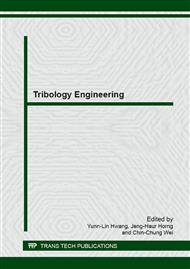p.147
p.152
p.162
p.168
p.174
p.179
p.184
p.190
p.196
Tribological Characteristics of Diamond like Carbon Coating in the Presence of Environment Friendly Vegetable Based Oils
Abstract:
Nowadays environmental awareness issue draws the attention of the scientists; lubricant industry also focuses on environment friendly lubricating oils. Therefore, vegetable oils draw the attention of scientists because of environmental friendly as well as good lubricating characteristics. However, good lubricating vegetable oils often shows inferior property because of low thermal stability, hence, to enhance the performance of vegetable oils self-lubricating diamond like carbon coating is considered, which helps in lowering the friction force which in turn lower friction induced heating, as a result stability of vegetable oils increases. In this current research, three vegetable based oils (sunflower, palm, coconut) are considered as lubricating oil. Tribological tests are conducted by ball on plate tribo-testing machine, tetrahedral type diamond like carbon coated plates and uncoated balls are used in the tribo-pair. Among the testing conditions sunflower oil shows good friction and wear characteristics and coconut oil shows inferior friction and wear characteristics.
Info:
Periodical:
Pages:
174-178
Citation:
Online since:
April 2015
Authors:
Price:
Сopyright:
© 2015 Trans Tech Publications Ltd. All Rights Reserved
Share:
Citation:


